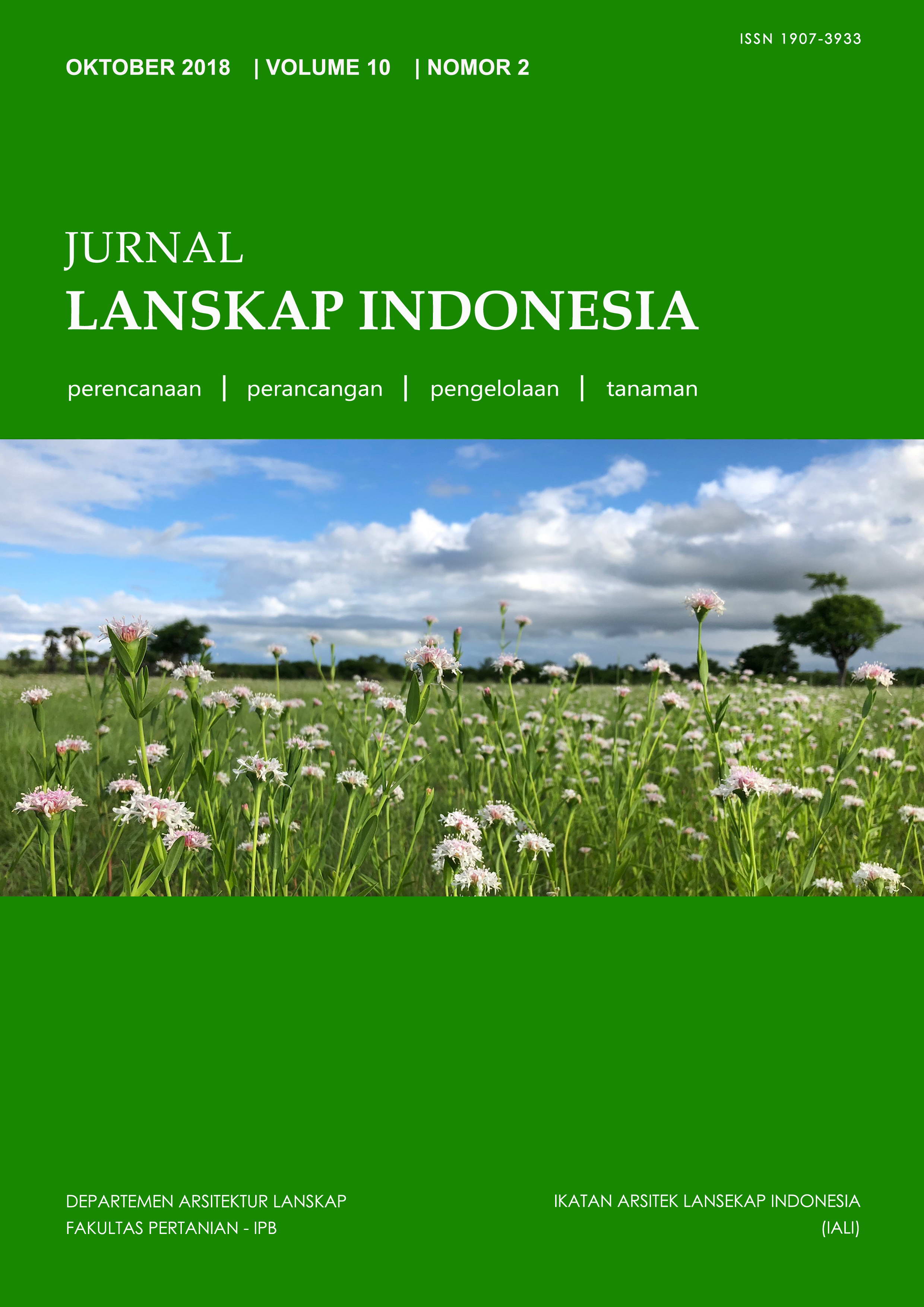PERENCANAAN LANSKAP KAWASAN WISATA DANAU BANDAR KHAYANGAN DI RUMBAI PESISIR, PEKANBARU RIAU
Abstract
Pekanbaru Government is currently increasing development to provide the activities of population needs. One of the development activities undertaken is development in the tourism sector. Bandar Khayangan Lake located in the district of Rumbai Pesisir, Pekanbaru City. The area has the potential of natural resources that can be used as a tourist attraction. Development of the area can cause damage the environment so that is necessary to provide a plan that can maintain the sustainability of this area. This research aims to analyzing and optimize the potential of Bandar Khayangan Lake and make a plan to create sustainable tourism areas. The result of research shows that most of the area is suitable to be used as tourist destination. Based on the analysis to keep the area sustainable, Bandar Khayangan Lake is divided into three zones between intensive zones, semi-intensive zones and non-intensive zones. The landscape plan consist of space plan, circulation, activities and facilities, and vegetation.
Downloads
References
[BMKG] Badan Metereologi Klimatologi dan Geofisika. 2016. Data Online Iklim BMKG [Internet]. [Diunduh pada tanggal 10 Maret 2017]. Tersedia pada http://dataonline.bmkg.go.id/data_iklim/download/?prov=4®=86&no=96109&name=96109%20STASIUN%20METEOROLOGI%20SULTAN%20SYARIF%20KASIM%20II&tglawal=01/01/2016&tglakhir=12/31/2016.
[BPS] Badan Pusat Statistik Kota Pekanbaru. 2015. Pekanbaru Dalam Angka. Pekanbaru (ID): Badan Pusat Statistik Kota Pekanbaru.
Brown RD, Gillespie TJ. 1995. Microclimate Landscape Design: Creating Thermal Comfort and Energy Efficiency. New York (USA): John Willey and Sons, Inc.
Daniel TC, Booster TC. 1976. Measuring Landscape Aesthetics: The Scenic Beauty Estimation Method. USDA Forest Service Research Paper Rm.
Gold, Seymor. 1980. Recreation Planning and Design. New York (US): The McGraw-Hill Companies Inc.
Ilham WT. 2010. Perencanaan Lanskap Kawasan Wisata Pesisir yang Berkelanjutan, Studi Kasus di Pesisir Teluk Pacitan Jawa Timur [Tesis]. Bogor (ID): IPB.
Inskeep E. 1991. Tourism Planning: An Integrated and Sustainable Development Approach. VNR Tourism and Recreation Series. New York (US): Van Nostrad Reinhold.
Kliskey AD. 2000. Recreation Terrain Suitability Mapping: A Spatial Explicit Methodology for Determining Recreation Potential for Resource Use Assesment. Landscape Urban Planning. 52:33-43.
McKinnon K, McKinnon J, Child G, Thorsell J. 1986. Pengelolaan Kawasan yang Dilindungi di Daerah Tropika. Yogyakarta (ID): Gadjah Mada University Press.
Nieuwolt S. 1977. Tropical Climatology: An Introduction to the Climates of Low Latitudes. London (UK): John Willey and Sons. 207p.
Rahantoknam. 2009. Kajian Potensi Sumberdaya Alam dan Lingkungan untuk Pengelolaan Ekowisata Pesisir Nuhuroa Maluku Tenggara. [Tesis]. Bogor (ID). IPB.
Tursilowati L. 2007. Use of Remote Sensing and GIS to Compute Temperature Huminity Index as Humancomfort Indicator Relative with Landuse and Land Cover Change (LULC) in Surabaya. Proceeding of the 73th International Symposium on Sustainable Humanosphere. LAPAN. Bandung. P: 160-66.
Yusiana LS. 2007. Perencanaan Lanskap Wisata Pesisir Berkelanjutan di Teluk Konga, Flores Timur, Nusa Tenggara Timur [tesis]. Bogor (ID): IPB.
This journal permits and encourages authors to post items submitted to the journal on personal websites or institutional repositories both prior to and after publication, while providing bibliographic details that credit, if applicable, its publication in this journal. However, after the article is submitted and published in this journal, it is fully copyrighted by the Jurnal Lanskap Indonesia or JLI. If excerpts from other copyrighted works are included, the author must obtain written permission from the copyright owner and give credit to the source in the article. Then, the writer or reader is allowed to copy, share, and redistribute articles/material in any form. But it must still include the appropriate source and credit because the article in this journal is licensed by Creative Commons Attribution 4.0 International License (CC BY 4.0).
I. Proposed Policy for Journals That Offer Open Access
Authors who publish with this journal agree to the following terms:
- Authors retain copyright and grant the journal right of first publication with the work simultaneously licensed under a Creative Commons Attribution License that allows others to share the work with an acknowledgement of the work's authorship and initial publication in this journal.
- Authors are able to enter into separate, additional contractual arrangements for the non-exclusive distribution of the journal's published version of the work (e.g., post it to an institutional repository or publish it in a book), with an acknowledgement of its initial publication in this journal.
- Authors are permitted and encouraged to post their work online (e.g., in institutional repositories or on their website) prior to and during the submission process, as it can lead to productive exchanges, as well as earlier and greater citation of published work (See The Effect of Open Access).
II. Proposed Policy for Journals That Offer Delayed Open Access
Authors who publish with this journal agree to the following terms:
- Authors retain copyright and grant the journal right of first publication, with the work after publication simultaneously licensed under a Creative Commons Attribution License that allows others to share the work with an acknowledgement of the work's authorship and initial publication in this journal.
- Authors are able to enter into separate, additional contractual arrangements for the non-exclusive distribution of the journal's published version of the work (e.g., post it to an institutional repository or publish it in a book), with an acknowledgement of its initial publication in this journal.
- Authors are permitted and encouraged to post their work online (e.g., in institutional repositories or on their website) prior to and during the submission process, as it can lead to productive exchanges, as well as earlier and greater citation of published work (See The Effect of Open Access).



























